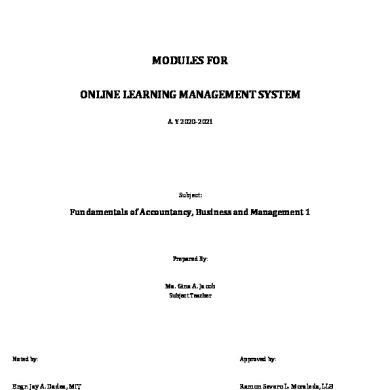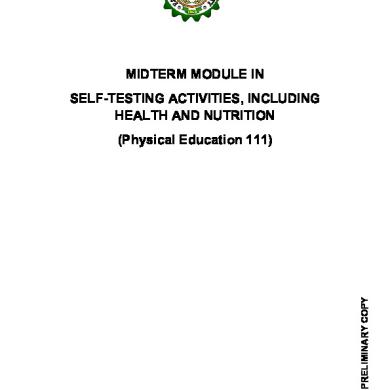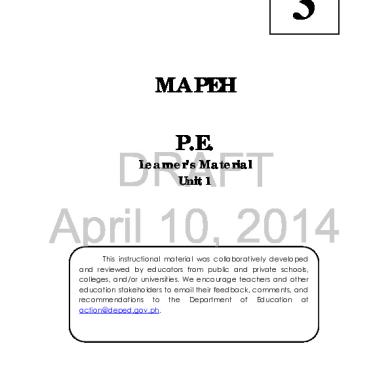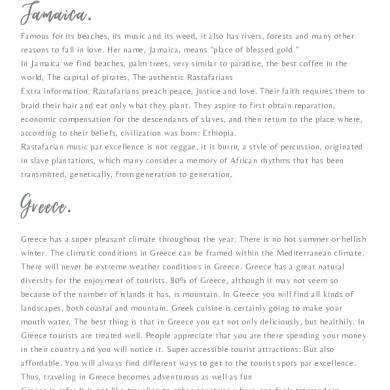* The preview only shows a few pages of manuals at random. You can get the complete content by filling out the form below.
Description
Horizontal Curves
• Horizontal Curves 1. Simple Curve – is a circular curve used to connect two tangents
intersecting at a point.
• Elements of a Simple Curve 1. Point of curvature (PC) the point where the curve leaves the first tangent; sometimes this point is called TC or tangent to curve. 2. Point of tangency (PT) the point where the curve joints the second tangent; sometimes called CT or curve to tangent. 3. Vertex (V) – the point of intersection of the tangents; also called PI or point of intersection.
• Elements of a Simple Curve 8. Radius (R) – radius of the curve. 9. Angle of intersection (I) – the deflection angle between the tangents. 10. Degree of curve (D) Arc Basis
Chord Basis
• Elements of a Simple Curve • Arc basis – In highway practice where the radius are usually short and usually the distances are considered to be the same as along the arc, the degree of the curve is the angle at the center subtended by an arc of one full station.
• Elements of a Simple Curve • Chord basis – Where the curve is relatively of long radius, distances along the arc of the curve are connected to be the same as along the chord. This is the angle subtended by the chord of one full station. Most railways work uses this degree of curve. In metric system, 1 full chord = 1 full station = 20m; In English, 1 full chord = 1 full station = 100ft.
• Elements of a Simple Curve 11. Sub-chord (C) – chord less than 1 full station. 12. Sub-angle (d) – angle at the center subtended by a sub-chord. 13. Length of curve (Lc) – total distance from the PC to PT.
•
• Formulas
•Radius, R Arc basis 𝑅 = Chord basis 𝑅 = •Tangent Distance, T 𝑇 = 𝑅tan •External distance, E 𝐸 = 𝑅 (sec − 1) •Middle ordinate, m m = 𝑅 (1 − cos )
• Formulas •Long chord, LC 𝐿𝐶 = 2𝑅𝑠𝑖𝑛
•
•Length of curve, Lc 𝐿𝐶 = 𝐿𝐶 = •Sub-angle 𝑑1 = 𝑑2 =
• Formulas •Sta. PC = Sta. V – T •Sta. PT = Sta. PC + Lc
• Notes 1. In route surveying, azimuth is measured from the south. 2. To obtain c1 think of a station (divisible by 20, greater than sta. PC) wherein if subtracted to sta. PC, its value must be less than 20; also to obtain c2 think of a station (divisible by 20, less than sta. PT) wherein if you subtract it to sta. PT, its value must be less than 20.
Sample Problems: • Two tangents of a simple curve have azimuths of 248°15’ and 294°30’ are connected by a 4.2° curve. If sta. V is at 7 + 196.25, compute the other elements of the curve. ▫
Given: 𝐴𝑧𝑖𝑚𝐵𝑇 = 248°15′ 𝐴𝑧𝑖𝑚𝐹𝑇 = 294°30′ 𝐷 = 4.2° 𝑆𝑡𝑎.𝑉 = 7 + 196.25
▫
Required: Compute the other elements.
• Solution: Note: to solve for the other elements of a simple curve, solve first the angle of intersection and radius. If you can see the formulas of other elements I and R is the requirement. • Like problem no.2 to solve I, subtract again the given azimuth of back tangent and forward tangent. 𝐼 = 294°30′ − 248°15′ 𝑰 = 𝟒𝟔° 15’ 𝑅= 𝑅= 𝑹 = 𝟐𝟕𝟐.𝟖𝟒 𝒎
•
Tangent, T 𝑇 = 272.84[tan ] 𝑻 = 𝟏𝟏𝟔.𝟐𝟒 𝒎. External Distance, E 𝐸 =272.84 (sec − 1) 𝑬 = 𝟐𝟑.𝟖𝟒 𝒎. Middle Ordinate, M m = 272.84(1 − cos ) 𝑴 = 𝟐𝟏.𝟗𝟐 𝒎.
•
Long Chord, LC 𝐿𝐶 = 2(272.84)𝑠𝑖𝑛 𝑳𝑪 = 𝟐𝟏𝟒.𝟑𝟏 𝒎 Length of the curve, 𝐿𝑐 𝐿𝐶 = 𝑳c= 𝟐𝟐𝟎.𝟐𝟒 𝒎 Alternative Solution 𝐿𝐶 = 𝐿𝐶 = 𝑳c = 𝟐𝟐𝟎.𝟐𝟒 𝒎
Station of Point of Curvature, Sta. PC 𝑆𝑡𝑎.𝑃𝐶 = 𝑆𝑡𝑎.𝑉 – 𝑇 𝑆𝑡𝑎.𝑃𝐶 = (7 + 196.25) − 116.24 𝑚 𝑺𝒕𝒂.𝑷𝑪 = 𝟕 + 𝟎𝟖𝟎.𝟎𝟏 Station of point of tangency, Sta. PT 𝑆𝑡𝑎.𝑃𝑇 = 𝑆𝑡𝑎.𝑃𝐶 + 𝐿𝐶 𝑆𝑡𝑎.𝑃𝐶 = (7 + 080.01) + 220.25 𝑚 𝑺𝒕𝒂.𝑷𝑻 = 𝟕 + 𝟑𝟎𝟎.𝟐𝟓
•
Sub – angles 𝑑1 = 𝑑2 =
To obtain c1 think of a station (divisible by 20, greater than sta. PC) wherein if subtracted to sta. PC, its value must be less than 20; also to obtain c2 think of a station (divisible by 20, less than sta. PT) wherein if you subtract it to sta. PT, its value must be less than 20. 𝐶1 = ( 7 + 100) − 𝑆𝑡𝑎.𝑃𝐶 𝐶1 = (7 + 100) − (7 + 080.01) 𝑪𝟏 = 𝟏𝟗.𝟗𝟗 𝒎 𝐶2 = 𝑆𝑡𝑎. 𝑃𝑇 − (7 + 300) 𝐶2 = (7 + 300.25) − (7 + 300) 𝑪𝟐 = 𝟎.𝟐𝟓 𝒎
•
𝑑1 = 𝑑2 =
• Sample Problems: • The deflection angle of two intermediate points A & B of a simple curve are 3°15’and 8°15’ respectively, from the PC. If the chord distance between A & B is 30m. Find the station of A & B if sta. PC is 4 + 120. Determine also the length of the curves from A to B. ▫ Given:
3°15’ 8°15 Sta. PC = (4+120)
β = 2θB - 2θA = 2(8˚15’) – 2(3˚15’) = 10˚ Consider half of the triangle: Solve for R and D Sin 5˚= ; R=172.06m 𝑅= 172.106 = D = 6.658˚
• For the Stations of point A and B Sta. A = Sta. PC + Lc-A Lc-A = = 19.525m Sta. A = (4+120) + 19.525 = (4+139.525) Sta. B = Sta. PC + Lc-B Lc-B = = 49.564m Sta. B = (4+120) + 49.564 = (4+169.564) • Length of the curve AB Lc A-B= Lc-B - Lc-A = 49.564 – 19.525 = 30.038m
• Horizontal Curves 2. Compound Curve -is a horizontal curve composed of two or more circular arcs of radii tangent to each other with their centers on the same side of the common tangent.
• Elements of Compound Curve ▫ PC – point of curvature ▫ PT – point tangency ▫ PI – point of intersection or V – vertex ▫ PCC – point of compound curve ▫ T1 – length of tangent of the first curve
•
• Elements of Compound Curve ▫ T2 – length of tangent of the second curve ▫ V1 – vertex of the first curve ▫ V2 – vertex of the second curve ▫ – central angle of the first curve ▫ – central angle of the second curve
• • Elements of Compound Curve ▫ I – angle of intersection = ▫ Lc1 – length of first curve ▫ Lc2 – length of second curve ▫ – length of first chord ▫ – length of second chord
•
• Elements of Compound Curve ▫ L – length of the chord from PC to PT. ▫ + = length of common tangent measured from V1 to V2 ▫ Θ=180°-I ▫ x and y can be found from triangle V1-V2-PI. ▫ TL = x + T1
•
• Elements of Compound Curve ▫ Ts = y + ▫ L can be found from triangle PC-PCC-PT ▫ Given the stationing of PC Sta. PT = Sta. PC + + ▫ Given the stationing of PI or V Sta. PT = Sta. PI – x – T1 +
+
Sta. PT = Sta. PI –TL +
+
• Elements of Compound Curve Notes:
▫ x and y can be found from triangle V1-V2PI. ▫ L can be found from triangle PC-PCC-PT
• Sample Problem: ▫ A compound curve has the following elements. I1=30˚, D1 =4˚, I2 = 24˚, and D2 = 5˚. If the stationing of the vertex is (4+620), a. Determine the stationing of PC. b. Find the stationing of PCC. c. Determine the Stationing of PT.
• Solution: Solve for I, R1, R2, T1, and T2 • I = I1 + I2 = 30˚ + 24˚ = 54˚
• 𝑅1 = = =286.479m • 𝑅2 = = = 229.183 •
𝑇1 = 𝑅1tan = 286.479 tan =76.762m
•
𝑇2 = 𝑅2tan = 229.183 tan = 48.714m
• Solution: a. Sta. PC = Sta. V – x -T1 To solve x, consider and use Sine Law,
= x= x = 63.084m Sta. PC = (4+620) – 63.084 – 76.762 Sta. PC = (4+480.154)
• Solution: • Sta. PCC = Sta. PC + Lc1 Sta. PCC = (4+480.154) + Sta. PCC = (4+630.154)
• Sta. of PT = Sta. PCC + Lc2 Sta. PT= (4+630.154) + Sta. PT= (4+726.154)













